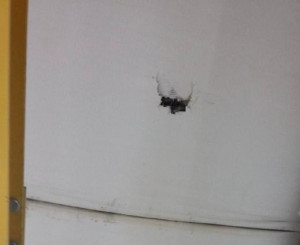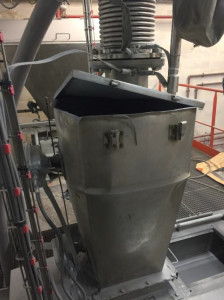At around 6:00 a.m., an explosion occurred inside the hopper of an aluminium metering feeder in the nitrate-fuel oil manufacturing shop of a civil explosives factory. Alerted by the noise, the factory’s employees cut off the shop’s main power supply. They saw blue-grey smoke exiting the cell housing the hopper was located. After making sure there were no flames, they entered the cell and saw that the aluminium metering feeder had been slightly deformed by the excess pressure. The explosion had ripped off a Plexiglas inspection hatch and sent it hurtling into an insulation panel in the cell’s ceiling, which was only slightly damaged. No other equipment in the immediate vicinity was damaged. There was very little material damage.
The metering feeder was emptied. The dust left by the explosion was swept up and, along with the aluminium recovered from inside the metering feeder, sieve analysed. The equipment was taken off and inspected. It appears that the high-level sensor in the aluminium feed hopper had stopped functioning. Its protective bonding was not guaranteed. Traces of heating were found on the sensor’s rod. This heating is the most likely energy source that triggered the explosion.
Maintenance had been performed on the equipment associated with the aluminium feed hopper a few days earlier. The shop had been returned to service following a series of no-load tests. The explosion occurred while the first mixing operation was being started under normal conditions (with a supply of aluminium) following maintenance.
The accident revealed a number of problems related to maintenance of the equipment:
- The maintenance plan was not sufficiently clear. As a result, maintenance had been carried out on only one of the two aluminium feed screws.
- ATEX equipment had been replaced by non-ATEX equipment.
- Maintenance operations on ATEX equipment had not been carried out in accordance with good engineering practice.
- The protective bonding of the equipment had not been checked during maintenance.
Following the event, the operator modified the maintenance plan (clearer wording, emphasis on raising the awareness of operators about maintaining ATEX equipment, systematic checking of the protective bonding of equipment after maintenance). It also changed the aluminium specifications (change in the grain size to reduce the risk of creating explosive atmospheres).





